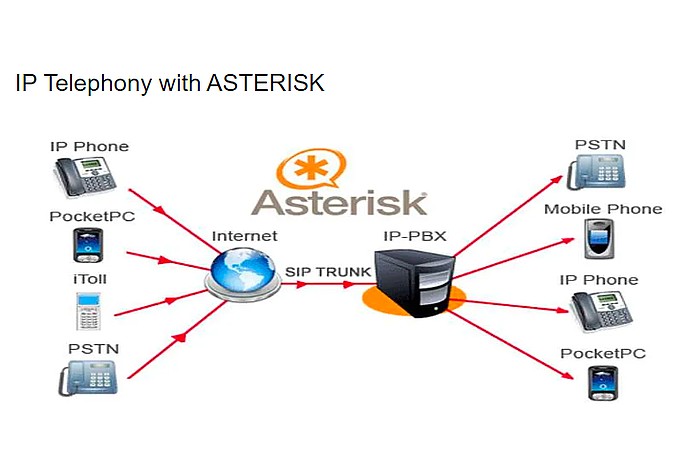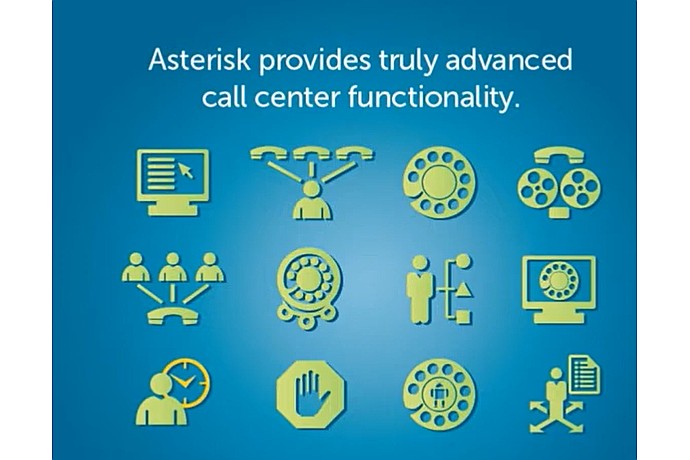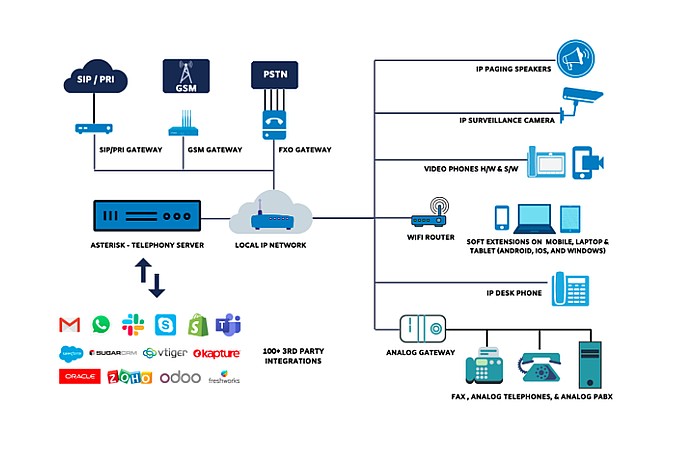
Language
Java
Tool Type
API, Desktop app, Mobile app
License
GNU General Public License version 2
Version
20.4.0
Asterisk

Asterisk acts as middleware, facilitating the creation of IP telephony systems, VoIP gateways, and conferencing servers. Its versatility makes it suitable for a wide range of business and government applications. Used globally by businesses of all sizes, Asterisk enables cost-effective, customized communication solutions. Promotes innovation in telecommunications by making advanced technologies accessible to organizations with different technical and budgetary capabilities.
Asterisk facilitates the implementation of advanced communication systems such as IP telephony and VoIP conferencing, allowing companies and government agencies to improve their communications infrastructure in a cost-effective manner.
1\. Voice Over IP (VoIP) Support: SIP (Session Initiation Protocol): Asterisk fully supports SIP, the most popular VoIP protocol. IAX (Inter-Asterisk eXchange): A protocol developed by the creators of Asterisk for efficient communication between Asterisk servers. 2\. Media Processing: Codecs: Supports a wide range of audio codecs such as G.711, GSM, and Opus. Media Streaming: Can stream music on hold and other media. Transcoding: Ability to convert media from one format to another. 3\. Modularity & Extensibility: Modules: Asterisk can be extended with modules, allowing tailored functionalities based on specific needs. Dialplan Scripting: Users can script the behavior of calls using the Asterisk Extension Language (AEL) or traditional dialplan scripts. 4\. Advanced Call Features: Call Queuing: For call centers and support lines. Interactive Voice Response (IVR): Automated systems to interact with callers. Voicemail: Built-in voicemail functionality. Call Recording: Ability to record calls for monitoring or compliance. 5\. Real-time Communication: WebRTC: Supports WebRTC for web-based real-time communications. WebSockets: Enables real-time web communications. 6\. Security: SSL/TLS: For secure communications. DTLS: Ensures secure communication for media streams in WebRTC. SIP Security: Features like digest authentication and STIR/SHAKEN for call integrity. 7\. Integration & APIs: Asterisk REST Interface (ARI): Allows for dynamic and remote configuration and management. LDAP Integration: For centralized user management in enterprise setups. 8\. Networking & Protocols: RTP (Real-time Transport Protocol): Used for delivering audio and video over IP networks. SRTP (Secure Real-time Transport Protocol): Provides encryption for RTP streams. 9\. High Availability & Scalability: While explicit clustering functionalities were not prominently visible in our codebase analysis, Asterisk's design allows it to be set up for high availability, redundancy, and scalability using external tools or specialized configurations. 10\. User & Endpoint Management: LDAP: Integration with directory services for user management. Dynamic Endpoint Configuration: Allows SIP devices to be easily managed and configured.
Configures and manages using .conf files, allowing customization according to specific needs. Employs SQLite for lightweight, serverless database functionalities. Utilizes the Jansson library for JSON data processing, facilitating modern web and API integration. Supports WEBRTC and WebSockets, ensuring compatibility with web communication standards. Implements security through SSL/TLS and DTLS, offering SIP and JWT-based authentication. Interacts with LDAP directory services for centralized user management. Designed with modularity,

Connect with the Development Code team and discover how our carefully curated open source tools can support your institution in Latin America and the Caribbean. Contact us to explore solutions, resolve implementation issues, share reuse successes or present a new tool. Write to [email protected]

This image depicts a network diagram for IP telephony using Asterisk, showing connections between IP phones, PocketPCs, the PSTN, mobile phones, and an IP-PBX through the Internet.

This image presents icons representing the various features of Asterisk's advanced call center functionality, emphasizing the software's comprehensive capabilities.

Asterisk Diagram: The telephony server connects SIP/PRI, GSM, PSTN via gateways to a local IP network. It integrates with IP phones, surveillance cameras, speakers, and over 100 third-party apps.
Complete guide on installing, configuring and using Asterisk.
Official list of open source tools endorsed by the Digital Public Goods Alliance. This tool is part of this registry.
Official forum for discussions, support and sharing of experiences between Asterisk users and developers.
Introductory video explaining the basics and configuration of Asterisk.
